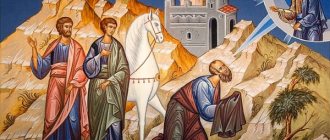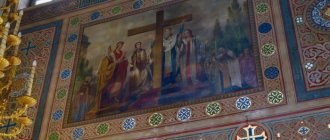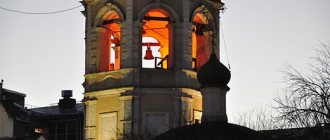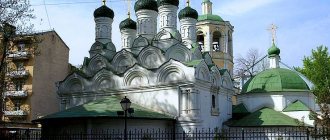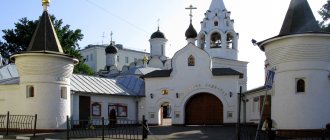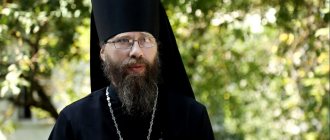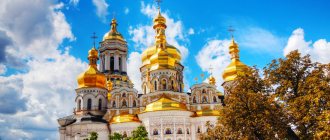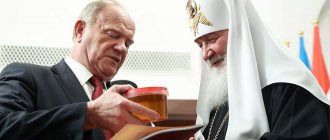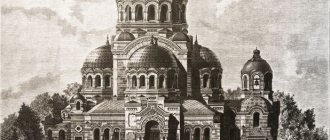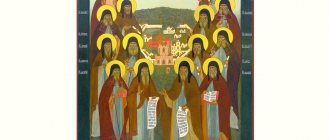Story
The history of the temple is closely intertwined with the farmsteads of the monasteries, which were located on the same territory. The monastery is a branch of a country monastery. It was needed so that priests and elders would stop in St. Petersburg during their trips.
In 1721, by decree of Peter I, a bishop's courtyard for the highest church governing bodies was founded on the site of the temple . The buildings belonged to the Holy Trinity Sergius Monastery.
In the middle of the 18th century, the monastery moved the courtyard to the Fontanka embankment, leaving behind the house church of the Nativity of Christ. Since 1756, no one bought the building; it was rented out for 10 years.
In 1766, Catherine II issued a decree on the transfer of buildings to the Pskov Bishops' House for the construction of a new courtyard. It was difficult to exercise control from Pskov, so in 1872 the buildings were again put up for sale.
From 1856 to 1874, the economic management of the metochion was carried out by the Holy Synod
In 1875, the ancient courtyard began to belong to the Kiev-Pechersk Lavra and was called Kiev. It included land, the Church of the Nativity, several service buildings and a warehouse.
By the 80s of the 19th century, the buildings and church of the courtyard were in a dilapidated state. The premises were crowded with monks and Kyiv bishops. Worldly people paid rent to live in this place. This negatively affected the status of the Kiev Pechersk Lavra. The internal and external spaces of church buildings were not organized harmoniously. In 1879, the architect P. I. Shestov erected a one-story outbuilding on the territory called the “Green House”. But the Nativity Church could not accommodate everyone.
Since 1891, Metropolitan Ioannikiy has been petitioning for a large-scale reconstruction of the metochion and his residence
In 1894, the architects were given a serious task - to present the Kiev Pechersk Lavra in the form of a new temple on Nevskaya Embankment, instead of the outdated courtyard. The competition was won by Vasily Antonovich Kosyakova. The author of such projects sought to combine spirituality and creativity in architecture.
In 1894-1895, a new complex of buildings appeared on Vasilyevskaya Island, which included:
- Assumption Church
- two-story Metropolitan building
- outbuildings for the brethren
- clergy house
- outbuildings: stables, carriage house, storerooms
- gardens
Residents of St. Petersburg showed great interest in the construction. People were waiting for the opening to visit the temple and hear traditional choral chants, which were much talked about in the press.
The layout of the residential buildings and the church were carefully thought out so that the noisy life of the capital did not pass through the gates of the temple
On December 18, 1897, the main chapel of the church was consecrated in honor of the Dormition of the Blessed Virgin Mary , and on December 19, the side chapel was consecrated in honor of the Council of All Reverend Fathers of the Kiev-Pechersk. By 1900, construction was successfully completed , the temple turned out to be beautiful and spacious.
The coup d'etat of 1917 meant the end of the peaceful life of the Kiev-Pechersk metochion and the usual way of life of its monastery. On September 29, 1926, the Kiev Pechersk Lavra was closed. The farmstead continued to exist independently. The authorities openly declared that they wanted to liquidate the Assumption Church. Since 1930, members of the monastic brethren began to be condemned for counter-revolutionary activities, arrested and sent to the Solovetsky camp and exile to Kazakhstan.
In 1934, the temple was officially closed. A gym was set up on the premises. Icons, an iconostasis and much other church equipment were removed from the church.
During the Great Patriotic War, the church premises were rebuilt as a warehouse for the Leningrad military port. The air defense observation post was hidden behind the dome of the temple. A bomb shelter was installed in the church basement, and the garden was used as an anti-aircraft crew.
In 1956, construction of an artificial turf ice skating rink began in the main church building. Dampness and moisture destroyed the expensive Metlakh tiles and paintings, the walls began to crumble and collapse.
After the skating rink, there were baths in the Assumption Church, then flowers were grown in the building. By the end of the 1980s, the complex of the former farmstead was occupied by various organizations and communal apartments.
Even before the revolution, the monastic authorities petitioned to open the Optina Pustyn monastery in the capital. Only in 1991, the abbot of the monastery, Archimandrite Evlogii, obtained permission from the city authorities. The temple of the Russian Orthodox Church was transferred to the Vvedensky stauropegial monastery of Optina Pustyn .
The restoration of the temple began. Restoring the building required large material, human and technical resources. Restoration work was organized in the administrative and economic parts of the farmstead. Along with the restoration, the way of life of the monks began to revive. The farmstead began to carry out social service and charity work.
Since November 2013, Abbot Arseny has been appointed Rector of the Optina Metochion in St. Petersburg
LiveInternetLiveInternet
From the Blagoveshchensky Bridge, which leads to Vasilyevsky Island from the center of St. Petersburg, the Church of the Assumption of the Blessed Virgin Mary is clearly visible.
I often admire the beautiful temple on the Lieutenant Schmidt embankment. Some special feeling arises when you look at it... Stunning architecture, magnificent domes of the majestic building...
Church of the Assumption of the Blessed Virgin Mary, Optina Compound
Have you noticed what the central chapter looks like? Doesn't remind you of anything? I think if someone was in the St. Nicholas Naval Cathedral in Kronstadt, they would immediately notice a similar drawing. Look. St. Nicholas Naval Cathedral in Kronstadt
It's simple: these churches have one architect - Vasily Kosyakov! This is how the handwriting appears.
The temple is amazing not only from the outside. Inside, it is made in the Byzantine style and resembles a Russian tower.
Church of the Assumption of the Blessed Virgin Mary, Optina Compound
Church of the Assumption of the Blessed Virgin Mary, Optina Compound
Ceiling painting Thanks to the bright colors, the interior decoration looks festive and solemn Ceiling in the vestibule
Candlesticks in niches
Iconostasis in the temple
Dome
Construction of the temple began on August 15, 1895... ...consecration took place in 1897
1721 is considered to be the year the farmstead was founded. Historically, this place belonged to different monastic farmsteads: in the middle of the 18th century, the Holy Trinity Sergius Monastery (now the Lavra), then the Pskov Bishop's House. From 1856 to 1874 it was under the jurisdiction of the economic administration of the Holy Synod. In 1875, at the proposal of Metropolitan Arseny (Moskvin) of Kyiv and Galicia, the ancient metochion began to belong to the Kiev-Pechersk Lavra.
The new church in honor of the Dormition of the Blessed Virgin Mary and the Venerables Anthony and Theodosius of the Kiev-Pechersk was founded on August 15, 1895 by the rector of the metochion, Archimandrite Feognost, according to the design of the outstanding architect Vasily Antonovich Kosyakov (1862–1921), author of the Naval Cathedral in Kronstadt, the Church of the Mother of Mercy on Bolshoy Prospekt, the Kazan Church of the Novodevichy Resurrection Monastery and a number of other well-known temple projects.
The courtyard complex rebuilt by V. A. Kosyakov included the Assumption Church, a two-story Metropolitan building on a high base, fraternal wings, a clergy house forming a courtyard space, service buildings (stables, carriage house, storerooms) and two gardens. The life of the monastic brethren was protected from the noisy life of the capital by the thoughtful layout of residential buildings and the church.
In the architecture of the Church of the Assumption of the Virgin Mary, V. A. Kosyakov managed to achieve a combination of the comfort of a house church with the spaciousness of a metropolitan cathedral. With all the rich and carefully executed decoration (yellow brick, mosaic, etc.), the main thing for him was to achieve expressiveness of the architectural ensemble
In 1900, construction work at the Lavra Compound was completed.
The current temple was built over 2 years, from 1895 to 1897. The compound complex was also rebuilt; together with the temple they form an architectural ensemble.
The peaceful life of the Kiev-Pechersk courtyard ended in 1917, during the coup d'etat. During these years, the monks of the metochion maintained the liturgical activities of the temple, but by March 1932 they were all arrested, convicted of counter-revolutionary activities and sent to the Solovetsky camp and into exile in Kazakhstan.
In June 1932, the Assumption Church of the Metochion was transferred from Stavropegial jurisdiction to the Leningrad Diocese; the metochion existed as a parish of the Assumption Church, consisting of faithful parishioners. At the end of 1933, forty-three people, the most active parishioners, were arrested. They were accused of preparing the murder of Stalin, two were subsequently shot.
Among the arrested parishioners was the church choir member Mikhail Vasilyevich Gundyaev (†1974), father of His Holiness Patriarch Kirill of Moscow and All Rus'. He sang in the amateur choir of Podvorye, where he met his future wife Raisa Vladimirovna Kuchina (†1984), mother of His Holiness Patriarch Kirill.
In January 1935, the church was closed and turned into a warehouse. At this time, all church property was destroyed, only the outer decoration of the temple survived - tiles, mosaic ornaments.
In 1961, the first artificial ice skating rink in Leningrad opened in the church. Refrigeration units were brought here, ice was poured in... The unique paintings were covered with plaster and painted over.
The world-famous Leningrad Figure Skating School began at this skating rink. The skating rink had a destructive effect on the building: due to constant dampness, the walls were damaged by fungus and collapsed.
Leningrad Figure Skating School
Church of the Assumption of the Blessed Virgin Mary, Optina Compound
Low temperature and constant humidity took their toll - the temple began to collapse. When it was returned to the Orthodox Church in the early 90s, it seemed that restoration was impossible. There was no floor, there were 7 layers of oil paint on the walls, the windows were warped...
However, it was the paint that saved the paintings—it literally preserved them. The restoration lasted 16 (!) years.
Church of the Assumption of the Blessed Virgin Mary, Optina Compound
In 1991, the temple was transferred to the Vvedenskaya Optina Hermitage for the organization of a metochion
Services in the temple resumed in 1993
Exit painting
The way of monastic life itself was gradually revived, and the activities of the parish developed. In 1993, services resumed in the southern aisle of the temple in honor of the saints of the Pechersk monks. The decoration of the Optina Metochion services was the singing of the male choir - an ensemble of professional singers, graduates of the St. Petersburg State Conservatory. This liturgical group was called upon to revive the lost traditions of ancient monastic singing. Thanks to the close cooperation of the choir with a group of medievalists, many song manuscripts that had been forgotten in the book depositories of monasteries and academic libraries again found their voice in the choir of the Metochion.
On September 15, 2013, His Holiness Patriarch Kirill of Moscow and All Rus' performed the rite of the Great Consecration of the restored Church of the Dormition of the Blessed Virgin Mary.
Today the temple is operational and looks great. Without knowing this whole story, it is difficult to imagine what happened to him.
Church of the Assumption of the Blessed Virgin Mary, Optina Compound
Many shrines are kept here, including icons painted on Holy Mount Athos, the relics of the venerable elders of Optina and a shrine with the relics of the wonderworker Ambrose of Optina.
Church of the Assumption of the Blessed Virgin Mary, Optina Compound
At the Optina Compound there is an icon-painting workshop where those interested are accepted for training.
I really liked that the priest on duty conducts the reception in the temple - he has a separate room, you don’t need to search throughout the temple. In addition, people who find themselves in difficult life situations can receive help, and on the notice board there is an appeal “Don’t have an abortion, we will help!” A lawyer provides free consultations here, and the homeless are helped with food.
If you don’t have such problems, just go to the Monastic Donuts cafe, where you can have a light snack or a good lunch. And in the temple itself you can buy excellent pastries and drinks prepared in the courtyard.
Daily statutory services, the revival of monastic life and the complete reconstruction of the architectural ensemble of the Metochion help transform this historical part of the city into a special island of spiritual life, which is a representation of the stauropegic monastery - the blessed Optina Hermitage.
via
The closest metro station to the temple is Vasileostrovskaya. The walk from there will take 15-20 minutes. The address of the building is Lieutenant Schmidt embankment, building 27/2. You can build a route using online maps.
Architecture
The Church of the Assumption of the Blessed Virgin Mary has high architectural value. The building has no supporting columns . The crisscrossing of concrete arches supporting the massive main drum created a large interior space. This was an innovative idea of the architect V. A. Kosyakov. New technology reduced construction time for the season and improved the acoustic properties inside. The architect did not skimp on materials during the construction of the Assumption Church. The result was excellent.
The capacity of the church is up to 2,000 people . Built from bricks and concrete mixture. 14 types of facing bricks were used. The lower tier is covered with gray granite, the upper – with sandstone. Russian mosaic artist V. A. Frolov, together with his students, created outdoor mosaics in the workshop. The smooth parts of the 5 domes are covered with aluminum sheets.
The temple is made in the pseudo-Russian architectural style, common in the 19th-20th centuries. The Russian-Byzantine direction combines elements of European culture and architecture and folk creative motifs.
Interior of the temple
The architect was able to achieve an amazing combination of a monumental cathedral and the comfort of a house church. V. A. Kosyakov managed to harmoniously fit the building into the panorama of Vasilyevsky Island.
The walls of the church were originally painted by Moscow masters. During the Soviet period, when the temple building was not used for its intended purpose, the paintings were covered with plaster, the walls were whitewashed, and painted over with oil paint in several layers. Cold and moisture accelerated the destruction. After the return of the Assumption Church to the church, restoration began , using photos from the archives and similar paintings by pre-revolutionary painters. This was done by groups of restorers and 80 graduates of the St. Petersburg State Academic Institute named after I. E. Repin . In 2013, the work was completed.
The interior painting of the dome depicts Christ with cherubs and seraphim. Under the drum there are compositions about the deeds of the Savior.
The theme of the central altar is the Dormition of the Blessed Virgin, the northern one is Archangels and Russian saints, the southern one is Savior Emmanuel. The altar contains a marble altar and a gilded porcelain iconostasis.
In the Assumption Church there are:
- icons with relics of Optina elders, healers and saints
- shrine with the remains of St. Ambrose, the Wonderworker of Optina
- particle of the Life-Giving Cross
- icon of the Mother of God “Quick to Hear”, painted on Mount Athos in 2009
- icons of the Mother of God “Vsetsaritsa” and the Mother of God “Inexhaustible Chalice”
Novodevichy Cemetery
Four years before the start of construction of the monastery, a place was allocated for the burial of people, which in our time is called the Novodevichy cemetery. When a site was allocated for the monastery building, the cemetery automatically became the property of the Orthodox community. In the first years of its existence, the cemetery was very small; few people were buried here. When it was transferred to the monastery department, it began to grow and become popular. Only representatives of the noble classes began to be buried here.
From 1845 to 1934, about 25,000 people were buried at the Novodevichy cemetery. Most of the burials were not preserved; only a few monuments remained, which vandals could not find use for.
Many famous people of Russia are buried at Novodevichy Cemetery: artists, poets, doctors, architects. It was popular among the St. Petersburg nobility and merchants. Thanks to this, many highly artistic sculptural monuments were installed in the cemetery.
After the revolution, most of the relatives whose loved ones were buried in the cemetery immigrated abroad, and there was no one to look after the burials. Rich graves became a good bait for atheists. During the times of general persecution and ban on the Orthodox faith in the post-revolutionary period, many burial places were looted and completely destroyed. The chapels and temples located at the cemetery were demolished.
At the beginning of the 21st century, the city committee for the protection of monuments collected archives of old documents and restored the names of 13,730 people buried at the Novodevichy cemetery.
Temple Today
The Church of the Assumption of the Blessed Virgin Mary is not only a spiritual, but also an educational center. At the courtyard they work:
- Sunday School
- gymnasium
- Institute of Religious Studies and Church Arts with two departments: theological and church arts
- icon painting school
- rehabilitation, which helps people who have suffered from the activities of destructive religious organizations and carries out preventive work to prevent involvement in sects
- gold embroidery workshop "Urbus"
- the male choir “Optina Pustyn” is the real pride of the temple, accompanies services in the tradition of ancient monastery chants
- a pilgrimage center that organizes excursions around the territory of the temple and the holy places of St. Petersburg; holds many meetings, concerts and discussions
- hotel
- cafe
Interesting Facts
- In 1875, the land of the then Pskov courtyard, along with buildings, was sold to the Kiev Pechersk Lavra for 86,000 rubles
- In 1922, a vessel for consecrating wine, crosses and Holy books were stolen from the premises of the Assumption Church. The brothers were accused of unauthorized storage of property
- Mikhail Vasilyevich Gundyaev, father of His Holiness Patriarch Kirill of Moscow and All Rus', was a member of the amateur choir of the Compound. There he met his future wife Raisa Vladimirovna Kuchina. In 1933, Mikhail Gundyaev, along with 42 parishioners, was accused of preparing the murder of Stalin and was arrested.
- On September 15, 2013, His Holiness Patriarch Kirill of Moscow and All Rus' performed the rite of great consecration of the restored Church of the Dormition of the Blessed Virgin Mary. This church rite is called the “renewal” of the temple: the building becomes holy, a place of God’s special presence on earth.
- The belfry houses six bells with a total weight of 1128 kg.
- The Compound and the Assumption Church are a cultural heritage site of federal significance
